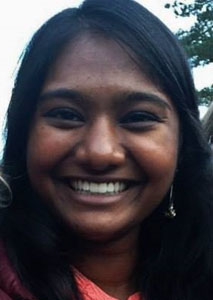
Nitya Ramanathan
USC Libraries presented its first-ever Research Award last month to a student who turned to the Visual History Archive to research transitional justice in South Africa and Rwanda.
Nitya Ramanathan, a junior international relations major, took first place for her paper How do We Put Ourselves Back Together? An Analytical Comparison between Transitional Justice in Rwanda and South Africa, written for Professor Wolf Gruner’s Comparative Genocide course.
USC Libraries’ Research Award encourages the exploration and use of the rich primary source materials held in the USC Libraries and celebrates the excellence of student primary source-based research. It was created by Special Collections librarians Michaela Ullmann and Sue Luftschein and made possible through a Challenge Grant sponsored by Dean Catherine Quinlan of the USC Libraries.
The jury, consisting of Professors Leo Braudy, Joseph Hawkins and Lindsay O'Neill, and undergraduate student Tyler Cundiff, paid special attention to the extent and effectiveness of the use of primary sources in selecting the winning papers. The winners were announced April 21 in USC’s Feuchtwanger Memorial Library.
The award, which was limited to undergraduate students during its inaugural year, is now open to undergraduate and graduate students from any field of study. For the 2015 Research Award, the first place award for graduate students will be $1,000, the first place undergraduate student winner will receive $500. The second place award for graduate students is $400, the second place undergraduate student award is $200. Papers may be submitted on an ongoing basis until the deadline of January 20, 2015.
Ramanathan said that after traveling to Rwanda she was interested in how Rwanda’s post-conflict justice process related to the South Africa Truth and Reconciliation Commission that is regularly upheld as the model for justice in post-conflict societies. As part of her research, she watched testimonies in USC Shoah Foundation’s Visual History Archive of Rwandan genocide survivors talking about their experiences with the Gacaca courts.
The testimonies were invaluable to her paper, she said, because they allowed her to incorporate first-hand testimonies of the people who were actually affected by the courts, and allowed her to analyze the courts from both the local and international level.
“Being able to see people's faces while they talked about the Gacaca courts was very meaningful to me because that is what really showed me what these people felt about the courts,” Ramanathan said. “Most of them had lost their whole families and had experienced horrible violence, something no court would ever be able to rectify, but people were able to understand that the courts were at least trying to help. I don't know if I could have been that understanding in their situation.”